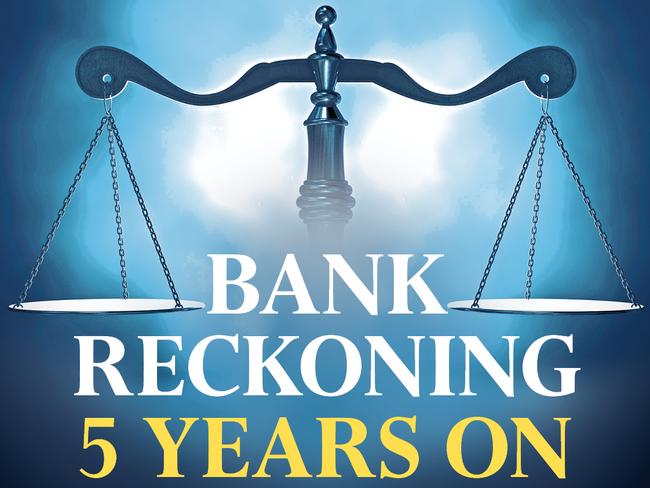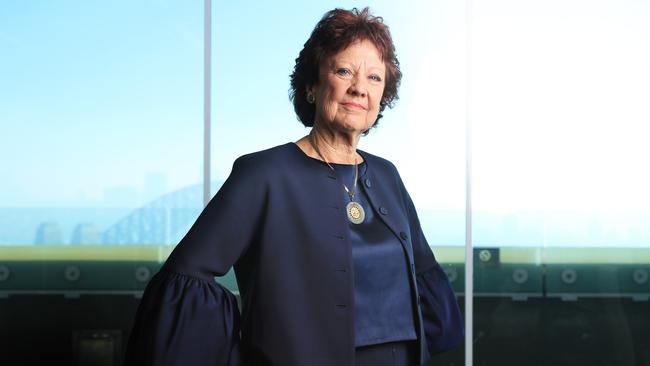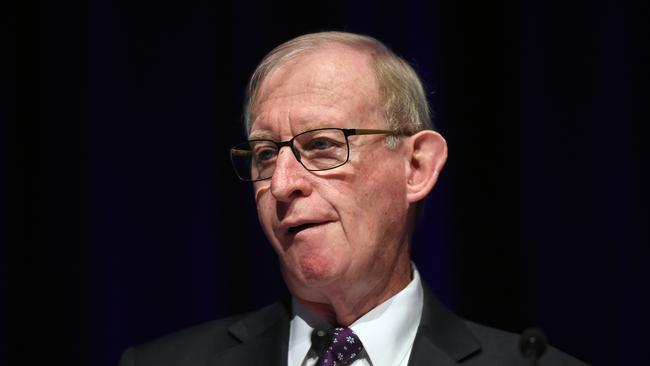The significant hurt and lingering pain embedded on AMP by the banking royal commission
Top figures from one of the biggest casualties of the banking royal commission, AMP, say the former wealth management giant was ‘significantly hurt’ by the bombshell inquiry.

Top figures from one of the biggest casualties of the banking royal commission, AMP, say the former wealth management giant was “significantly hurt” by the bombshell inquiry, sparking a “wake-up call” for the entire industry.
Former chair David Murray, who was charged with shepherding the company through the year of the royal commission and immediately after says the financial services operator was “significantly hurt” by the fallout from the royal commission, which he describes as “politically motivated” and a “star chamber”.
“It suffered very considerably from the royal commission,” he said in an interview with The Australian.
“Some of it was because of the way it was conducted (and) some of it because the financial advice industry had to be dealt with.

“It took so much energy out of the company with all the publicity, at a time when it had to make a significant turnaround in its strategy.”
“Its method of inquiry was overreach and the commission was conducted as a star chamber.
“AMP and the industry really didn’t have a chance of putting up with this star chamber stuff.”
He said the impact of the commission made it harder to make the necessary changes needed to transform the company and led to some “real hurt” for executives in the financial industry, some of whose reputations never recovered.
Debra Hazelton took over from Mr Murray as AMP chair in August 2020 and said the inquiry had proved a catalyst for change.
“In the five years since (the royal commission), we have transformed both structurally and culturally, repositioning AMP for the future,” Ms Hazelton told The Australian.
“We have new leadership, an embedded customer-led purpose, divested significant parts of our business and greatly simplified in other areas.”
AMP was a key early focus for the commission given its long-time reliance on commissions for selling wealth management products and its admissions that, in some cases, it had charged fees for services never delivered.
Under pressure in the witness stand, its then head of advice, Jack Regan, was an early victim of the commission’s tough questioning, admitting AMP had misled corporate regulator ASIC over the issue of charging for advice not delivered.
In his final report in February 2019, commissioner Kenneth Hayne found that AMP “accepted that it was open to the commission to find that the fees-for-no-service conduct was attributable, at least in part, to the culture and governance practices within AMP”.

Ms Hazelton argues that much has changed at AMP since the dark days of 2018, which saw the swift exit of former chief executive, Craig Meller, chair Catherine Brenner and two fellow directors, wiping more than $2bn off the company’s share price in a few months.
As it sought to come to terms with reputational damage from the commission as well as long-time structural issues, the next few years saw the company buffeted by many storms including the high-profile departures of chair Mr Murray, his appointee as chief executive, former Credit Suisse executive Francesco De Ferrari, and controversial AMP Capital chief Boe Pahari.
The company’s reputation was dealt a further blow with the ruling in September 2022 by the Federal Court that companies in the AMP group should pay $14.5m in penalties for charging fees for services that were not provided to more than 1400 clients.
Ms Hazelton is looking to the future, arguing that the changes of the past few years have allowed AMP to “strengthen governance, innovate and, most importantly, deliver better experiences for our customers and partners”.
“This will drive the long-term growth of our business, where we see significant opportunity to help more Australians retire with greater financial confidence,” she said.
Ms Hazelton admitted that the fallout from the commission was still front of mind for the organisation: “The lessons learned continue to motivate our people to do the best for our customers, whose trust is precious and earned.”
Ms Hazelton and chief executive Alexis George, who took over in August 2021, have worked hard to steady the ship.
But the question being asked by investors is: have they been able to do enough? Or do AMP’s structural problems and its current more modest place in highly competitive wealth management and banking sectors mean more challenges are ahead as it bids to carve out a more sustainable future?
With the sale of once key assets, such as its life insurance arm and AMP Capital, AMP today is a much smaller, simpler organisation than it was five years ago – in terms of operations, market share in its remaining areas of operation and market capitalisation.
Despite the years of change, AMP shareholders have done it tough, with shares that were trading near $5 at the beginning of 2018 now trading below $1. The company’s market capitalisation is down to only $2.6bn from almost $14bn before the commission started its hearings.

Changes at the company have included the settlement of key legacy issues, including shareholder actions and against and the long-running “buyer of last resort” actions from its agents last year.
The company has worked through its customer remediation program, launched its new “customer-led purpose”, and continues to trim costs.
The appointment of Ms George as CEO and other new directors have been part of a “board renewal” process.
The company lists other changes as renewing its enterprise risk management framework to “ensure all employees have clarity and training on how risks are managed so we can fulfil our obligations to key stakeholders, including customers”.
It has simplified its superannuation products and created a new in-house investment arm, AMP Investments, and launched a new annuity-style retirement income product, MyNorth Lifetime.
AMP has retained its banking arm, despite selling off other profitable businesses.
Some observers believe it could be for sale at the right price, but so far potential suitors have not come anywhere near what price would be needed for a sale.
Others point out that its profit contribution from the banking business now makes it a key part of the business.
The company last year announced plans to spend $60m on a digital banking platform for small businesses, but it also warned that net interest margins, a key measure of bank profitability, were under pressure.
The past few years have seen it grow the share of its North platform in the independent financial advice market.
The company points out it resumed paying dividends in the financial year to June 2022 and has been committed to returning $1.1bn to shareholders.
AMP was an early casualty of the royal commission, which shone a spotlight on a broader industry issue of charging for services that were not delivered.
The commission dealt a body blow to private sector superannuation and wealth management, paving the way for further growth in the industry superannuation sector.
Observers say they believe chair Ms Brenner, in particular, was unfairly treated.
They argue that she was active in reporting to ASIC the issue of fees being charged for no services well before the commission was announced, and was working with the regulator on a process that would have led to an enforceable undertaking had the commission not been set up.

They also argue that Mr Regan was not prepared for the tough questioning he received in the box, putting the company on the backfoot when he admitted AMP may have misled ASIC.
Ms Brenner was never called to appear, but got caught in the line of fire over questions over her involvement in a report delivered to the AMP board.
It was only after ASIC issued a statement in 2020 saying that there would be no action against her that she was able to resume a blue-chip director career after more than two difficult years.
Some other executives in the wealth management industry were not so fortunate.
AMP had many other problems before the royal commission as a result of its takeover of GIO and the Australian operations of AXA, and the winds of change in the superannuation industry with growing complaints about commissions and the rising power of industry super funds – as well as legacy issues such as its long-time agreement with life agents to buy them out at a generous rate if they wanted to retire.
Subsequent issues such as the controversy over the appointment of Mr Pahari as head of AMP Capital had nothing to do with the royal commission, although they did come at a time when the company’s reputation was already vulnerable.
Superannuation industry veteran and former Challenger executive Jeremy Cooper says problems with AMP’s business model of “dependency on its financial advisers and the conflicted remuneration was evident long before the commission started”.
“The royal commission was just one of the many factors affecting the company in the past decade,” Mr Cooper said.
“But it highlighted the shortcomings of its conflicted and outdated business model.”
Barrenjoey analyst Andrew Adams says it is “hard to distinguish what may have happened to AMP as a result of the royal commission and what has been due to other factors”.
“There are many moving parts in what has happened,” Mr Adams said. “AMP was once a dominant player in the wealth management sector which drove group earnings. But it now gets the majority of group profit from its banking division, where it is a small player in a competitive industry. AMP was a wealth management company, now it is mainly a bank with a wealth management arm.”
APOLOGY TO JACK REGAN
In January 2024, The Australian published an online and print article regarding the 2018 Royal Commission into Misconduct in the Banking, Superannuation and Financial Services Industry. In the articles, The Australian stated that Jack Regan, then Group Executive, Advice and NZ at AMP, had misled ASIC in relation to the issue of charging for advice that was not delivered. This statement was an error and it should not have been published. The Australian withdraws the suggestion that Mr Regan personally misled ASIC and apologises to Mr Regan for any harm or distress caused to him and his family.


To join the conversation, please log in. Don't have an account? Register
Join the conversation, you are commenting as Logout